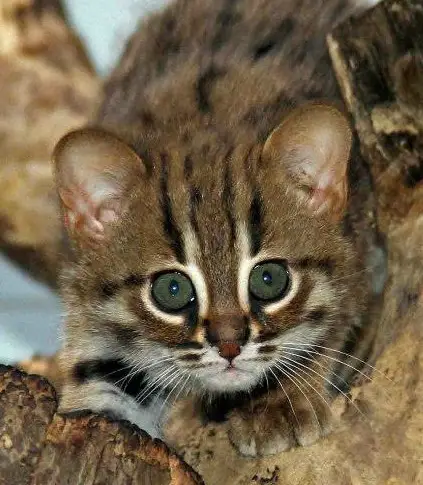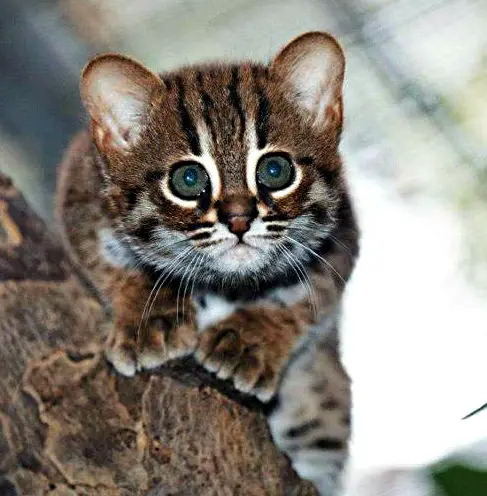Berlin Zoo has announced the birth of its first rusty-spotted cat kittens since it opened 168 years ago. Nicknamed ‘the hummingbirds of the cat family’, rusty spotted cats (Prionailurus rubiginosus) rival the black-footed cats (Felis nigripes) of southern Africa for the title of world’s smallest wild cat. Their long bodies and tails, which can reach a total of 78 cm in the largest males, might out-stretch their African relatives, but they’re just a little bit lighter at 0.9 – 1.6 kg. To put this in perspective, the world record for the smallest adult tabby cat is 1.36 kg.
Berlin Zoo’s two new kittens were born on August 5, would have weighed somewhere between 60 – 77 g. They’re not an easy species to breed – compared to the domestic cat’s estrous cycle (when the cats are ‘on heat’ and ready to mate) of 14 to 21 days during breeding season in spring, the rusty-spotted cat’s estrous lasts just five days. And she’ll only ever have one or two kittens in a litter, born after a gestation period of around 67 days.
Unlike another very rare and small wildcat species, the Scottish wildcat, rusty-spotted cats are easy to tame, and there have been some reports of this species being bred with domestic cats. Nineteenth century British physician and zoologist Thomas C. Jerdon kept a number of rusty-spotted cats in his home for research, and according to Wild Cats of the World by Swiss naturalist and writer Charles Albert Walter Guggisberg, he said of them, “I had a kitten brought to me when very young in 1846, and it became quite tame, and was the delight and admiration of all who saw it. Its activity was quite marvellous and it was very playful and elegant in its motions.”
In his 1884 book, Natural History of the Mammalia of India and Ceylon, British naturalist Robert Armitage Sterndale described his experience with some rusty-spotted cats,
“I had two kittens brought to me by a Gond in the Seonee district [in Central India], and I kept them for many months. They became perfectly tame, so much so that, although for nine months of the year I was out in camp, they never left the tents, although allowed to roam about unconfined … At night the little cats were put into a basket … and on my arrival next morning I would find them frisking about the tent roof between the two canvasses, or scrambling up the trees under which we were pitched.”
Whilst I was at work I usually had one in my lap and the other cuddled behind my back on the chair. One day one of them, which had been exploring the hollows of an old tree close by, rushed into my tent and fell down in convulsions at my feet. I did everything in my power for the poor little creature, but in vain, it died in two or three minutes, having evidently been bitten by a snake. The survivor was inconsolable, refused food, and went mewing all over the place and kept rolling at my feet, rubbing itself against them as though to beg for the restoration of its brother.
At last I sent into a village and procured a common kitten, which I put into the basket with the other. There was a great deal of spitting and growling at first, but in time they became great friends, but the villager was no match for the forester. It was amusing to see the wild one dart like a squirrel up the walls of the tent on to the roof; the other would try to follow, scramble up a few feet, and then, hanging by its claws, look round piteously before it dropped to the ground.”

Berlin Zoo’s rusty-spotted cat kitten. Credit: Berlin Zoo
The rusty-spotted cat’s habitat is restricted to India and Sri Lanka, and these populations have adapted to such different types of environments, they have been separated into two subspecies, r. rubiginosus India and r. phillipsi Sri Lanka. In Sri Lanka, they prefer the thick, tropical forests, and in India, they take to the dry grasslands and open forests. Their restricted habitat makes them one of the many threatened wildcat species in the world. According to the IUCN Red List, they’re down to 10,000 mature individuals in the world, which puts them at the ‘vulnerable’ end of the scale, and due to habitat loss caused by logging, plus the fur trade, their numbers continue to dwindle.
